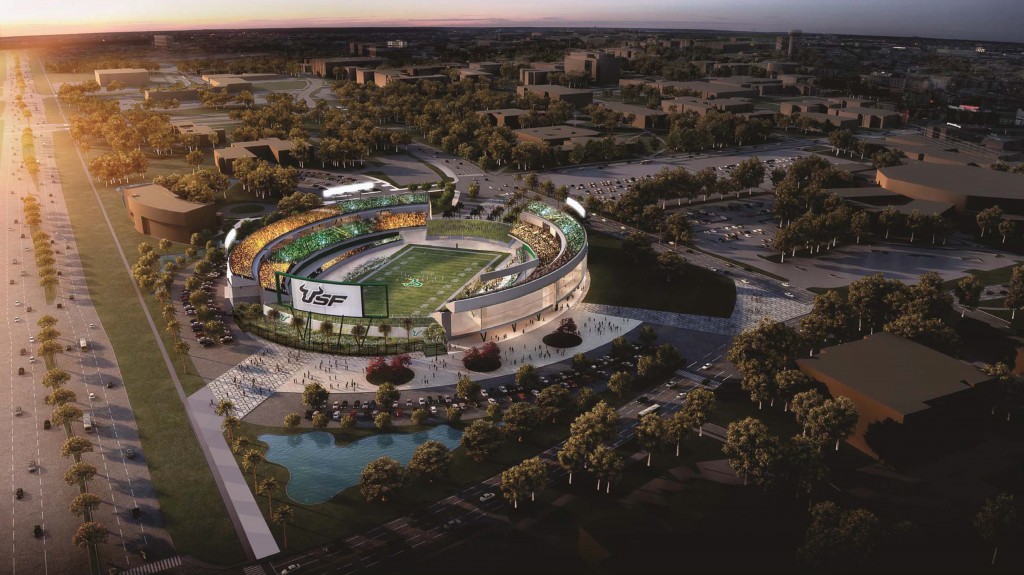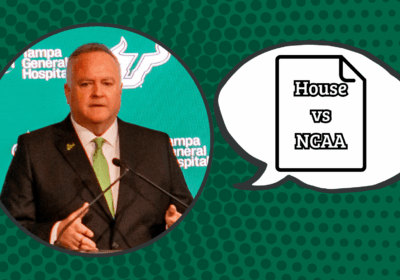USF should invest in other operations rather than a stadium, some faculty say

It was in the rumor mill, but unexpected by faculty, that the Sept. 8 groundbreaking of the university’s newest $22 million indoor practice facility would also reintroduce the beginning of a longtime USF goal — to have its own football stadium.
No new updates have been released on USF’s plans to build a stadium, however, after BOT Chairman Will Weatherford’s remarks, the topic has been in the air ever since. For some faculty, the main concern around the idea is monetary, and how it would impact the university’s finances in the future.
The proposed athletic venue should not be high on the list of the university’s priorities, according to Faculty Senate President Timothy Boaz.
“I wouldn’t say I think it’s necessary. There are advantages to having an on-campus stadium. It is a focal point for social activity and students on campus, which is a good thing, and it’s expensive, which is not a good thing,” said Boaz.
Boaz’s financial concerns come from an estimated price tag of $200 million to build an on-campus stadium, projected in a 2018 conceptual planning study by The Beck Group, a Dallas-based construction company. Several funding methods were in consideration at the time the study was released, including student fees.
Students voted on a referendum in 2018 to determine if they would be willing to pay a $6 to $9 per-credit-hour fee to help finance an on-campus football stadium. The responses, however, weren’t in favor of the potential addition.
Of 1,753 votes, 48%, or 814, of students voted against implementing the fee. Around 668 students voted in favor, while 271 had no preference, according to a 2018 Oracle article.
Boaz said the money allocated for a potential stadium should alternatively be used to fund other university operations that have a higher need of financial resources.
“We have infrastructure issues related to office space, classrooms and IT,” Boaz said. “We have a lot of needs at USF right now and there are many faculty that would rather see those addressed first. So, that means it might be a while before we would do the stadium. We’ll see.”
William Lang, vice president of the USF United Faculty of Florida and faculty representative to the Athletic Council said the stadium must first prove its monetary worth before the university moves ahead with the plans.
“I think if USF can build a stadium, and it’s a positive impact on diversity, great, do it,” Lang said. “If it’s going to be something that’s a burden to the university, that takes a lot of money away, I would be against it.”
No updates regarding USF’s plan to proceed with a stadium project had been announced as of Tuesday night. In an email to The Oracle, Assistant Director of Media Relations Althea Johnson said updates will be announced “soon.”
“Right now, [Weatherford] has nothing to add to his comments from last month,” Johnson said. “[Weatherford] believes the time has come for USF to build an on-campus stadium and looks forward to updating the community soon.”
During the Sept. 29 faculty senate meeting, Brian Connolly, associate professor in the department of history, said the senate should discuss the matter in the future because it can negatively affect the institution’s academic mission.
“Regardless of what people’s beliefs are, the evidence across the country is that building football stadiums on university campuses are massive, massive money losers,” Connolly said.
The University of California, Berkeley is among some institutions that have gone into debt as a result of multimillion-dollar investments in new athletic facilities and major renovation to its stadium. Combined, the university spent $321 million and ran a $22 million deficit in 2016 in depth, according to a 2017 Bloomberg article.
While a location hasn’t been announced, the university has made it clear that the stadium would be located within campus borders. Boaz said the stadium may not bode well with USF’s current situation due to infrastructure and underfunded academic programs.
“We’re a university that’s struggled to get the kind of budget that we need to operate at the level we want to operate on. I think people will be more concerned about devoting resources in this direction rather than supporting research, classroom activities and stuff like that,” said Boaz.
Richard Manning, associate professor in the department of philosophy, said the resources of the stadium could be better directed toward academic endeavors.
“I do wish that energy were directed toward developing donations that would support faculty hiring and infrastructure development for the academic mission,” Manning said.
The potential stadium, according to Connolly, could become a financial burden for the university.
“The general trend of football stadiums on university campuses across the country is that they end up as relatively empty, money-losing endeavors that threaten the financial stability of the universities,” Connolly said.
Berkeley will be paying $18 million a year until 2032 to pay back its loan for the stadium’s renovation, which was completed in 2012. The loan payments will then increase to $26 million, then $37 million in 2039, according to Bloomberg. It’s projected to pay off the loan by 2053, a total of over 30 years in debt.
If revenue generated from the proposed venue were used to fund other historically underserved university programs, both athletic and non-athletic, it could be a potential benefit, Lang said.
“If the money that’s generated by the stadium is used to fund other parts of the athletic department, so that there are athletic opportunities for other sports that do not generate revenue, that’s a great use of extra revenue,” he said.
“That money [could be] used to pay for men’s and women’s soccer, a junior gymnastics program and opportunities for 100 or 200 athletes, [athletic] experiences for women and maybe international students who wouldn’t have a chance to go to college otherwise.”







